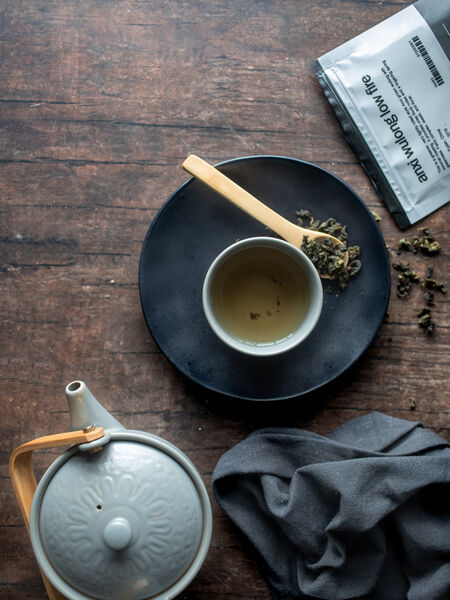Comparing Chinese & Taiwanese Oolongs


Oolongs are an interesting tea. Not quite a green tea and not quite a black tea, a lot of time and thought goes into making an oolong, and each brewing offers a different experience with new nuances. Though other countries have small oolong industries, most oolongs come from China or Taiwan. Where an oolong comes from can widely affect its flavor, but what’s the difference between oolongs from China and Taiwan? Let’s take a look at the different approaches to this subtle genre of tea.
Production
The production of Oolong is a complicated process that includes multiple steps to produce the perfect oolong. Each manufacturer of oolong, whether in China or Taiwan, has their own techniques for each type of oolong (check out what generally goes into oolong production). However, there are certain characteristics that stand out in both Chinese and Taiwanese oolongs.
China’s oolongs are mainly produced in Fujian and Guangdong provinces, though other regions produce their own oolongs as well. The tea leaves are almost entirely picked by hand with the leaves being plucked individually from the tea bush. Teas from the Anxi County and Wuyi Mountains in Fujian province are grown at high altitudes with some of the finest and most expensive coming from Wuyi. Generally speaking, Chinese oolongs are more oxidized and baked longer at higher temperatures than Taiwanese oolongs.
Since it’s an island with limited space, Taiwan has a small tea industry, but 90% of its tea industry is dedicated to oolongs. Inspired by Fujian’s oolong production, Taiwan produces their own version of many Fujian oolongs with their own developed techniques. The leaves used in Taiwanese tea can be harvested either by hand or machine with the leaf set usually intact. Generally, tea harvested by hand are more expensive than those harvested by machine.
Leaf Shapes and Styles
Chinese and Taiwanese have their preferred methods of shaping the tea leaves, but producers in both China and Taiwan use the semi-rolled style to shape their oolongs. The tea is formed into a ball shape which unfurls during brewing, releasing the flavors of the leaf.
Strip Style Oolongs are unique to Chinese oolongs and are used in oolongs from the Wuyi Mountains, which are called rock or cliff teas. These oolongs feature twisted leaves and are dark in color due to being heavily oxidized (50-80%) as well as roasted.
The Open Leaf Style is a technique found in Taiwanese oolongs, notably in Oriental Beauty. This style of leaf is open and leafy with a slight curl, and while some lower quality teas can be roasted, the higher end open leaf oolongs are not. These oolongs can have light or medium levels of oxidation, making them closer to a green tea than a black tea.
Flavors and Aromas
Because they tend to be baked and heavily oxidized, Chinese oolongs produce darker, heavier cups of tea with little astringency. In particular, rock teas have strong flavors due to their being heavily roasted. However, roasting can vary among Chinese oolongs, with some being lightly roasted for a milder flavor. Guandong oolongs are known for having flavors and aromas that mimic flowers and fruit, some being described as having hints of grapefruit, ginger, almond, and orchid among others.
Because the weather is unpredictable, Taiwanese oolongs can vary from season to season; however, because of the variety of landscapes and weather (including high mountains, plains, weather, temperature, etc.), Taiwanese oolongs are available in a wide variety of flavors. Some Taiwanese oolongs can be mild and less oxidized (or closer to a green tea), while some can be more robust and very heavily oxidized (or closer to a black tea).
Check These Teas Out!
Ready to sample some Chinese and Taiwanese oolongs for yourself? Here are some popular choices to try!
Chinese Oolongs
• Tie Kuan Yin: One of China’s most beloved oolongs, Tie Kuan Yin is named after the Iron Goddess of Mercy in Buddhist traditions. Known for its slightly mineral flavor, Tie Kuan Yin varieties can be lightly roasted or medium roasted and sometimes roasted multiple times. There are even Taiwanese varieties available, though the traditional version is from Fujian province.
• Anxi Wulong Low Fire: Tightly rolled and minimally roasted, this oolong is similar to a green tea. It has a mild, sweet flavor which makes it a perfect alternative to more heavily roasted oolongs.
• Ma Liu Mi: Also known as Hou Zi Cai, this spring oolong comes from the same area as Tie Kuan Yin. While Tie Kuan Yin can be roasted multiple times, this oolong is only roasted once, enhancing the flavor but maintaining its floral and green-like flavor.
Taiwanese Oolongs
• Ali Shan Special: Grown in the mountainous Ali Shan area, this tea is one of Taiwan’s best known oolongs. The leaves used in Ali Shan take longer to grow due to the location and cool climate, but the results are a higher level of nutrients for a sweetly rich cup.
• Formosa Fancy Bai Hao: Also known as Oriental Beauty, Bai Hou is a heavily oxidized oolong (80% oxidation), similar to a black tea. Only harvested in the summer and left unroasted, it has a very clean flavor with a slightly fruity aroma.
• Wen Shan Pouchong: Also known as Baozhong, this tea has very little done to it during production; it’s even minimally shaped with light twists and gentle curves. This oolong has a floral aroma and flavor, and a perfect choice for a delicate cup.
